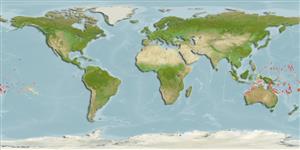Environment: milieu / climate zone / depth range / distribution range
Ökologie
seewasser riff-verbunden; tiefenbereich 1 - 10 m (Ref. 30874). Tropical; 16°N - 25°S
Pacific Ocean: Christmas Island in the eastern Indian Ocean to the Mariana, Marshall, Samoan, Tuamoto, and Pitcairn islands. Recently reported from Ouvéa Atoll, Loyalty Islands (Ref. 13236). May be conspecific with Chalixodytes chameleontoculis of the western Indian Ocean.
Size / Gewicht / Alter
Maturity: Lm ? range ? - ? cm
Max length : 4.6 cm TL Männchen/unbestimmt; (Ref. 90102)
Rückenflossenstacheln (insgesamt): 0; Rückenflossenweichstrahlen (insgesamt): 35-37; Afterflossenstacheln 0; Afterflossenweichstrahlen: 36 - 38. Scales present on back, in front of the dorsal fin.
Occurs in loose coral sand of shallow exposed seaward reefs and sandy shorelines to a depth of at least 10 m (Ref. 1602).
Life cycle and mating behavior
Geschlechtsreife | Fortpflanzung | Ablaichen | Eier | Fecundity | Larven
Myers, R.F., 1991. Micronesian reef fishes. Second Ed. Coral Graphics, Barrigada, Guam. 298 p. (Ref. 1602)
IUCN Rote Liste Status (Ref. 130435)
Bedrohung für Menschen
Harmless
Nutzung durch Menschen
Mehr Information
NamenSynonymeMetabolismusRäuberÖkotoxikologieFortpflanzungGeschlechtsreifeAblaichenSpawning aggregationFecundityEierEientwicklung
ReferenzenAquakulturAquakultur ProfilZuchtlinienGenetikElectrophoresesVererbbarkeitKrankheitenVerarbeitungNutrientsMass conversion
PartnerBilderStamps, Coins Misc.LauteCiguateraGeschwindigkeitSchwimmstilKiemenoberflächeOtolithsGehirngrößeSehfähigkeit
Tools
Zusatzinformationen
Download XML
Internet Quellen
Estimates based on models
Preferred temperature (Ref.
123201): 25.5 - 29.4, mean 28.4 °C (based on 906 cells).
Phylogenetic diversity index (Ref.
82804): PD
50 = 0.7500 [Uniqueness, from 0.5 = low to 2.0 = high].
Bayesian length-weight: a=0.00389 (0.00180 - 0.00842), b=3.12 (2.94 - 3.30), in cm total length, based on all LWR estimates for this body shape (Ref.
93245).
Trophic level (Ref.
69278): 3.2 ±0.4 se; based on size and trophs of closest relatives
Fishing Vulnerability (Ref.
59153): Low vulnerability (10 of 100).
Nutrients (Ref.
124155): Calcium = 199 [93, 408] mg/100g; Iron = 0.94 [0.50, 1.75] mg/100g; Protein = 17.9 [16.6, 19.1] %; Omega3 = 0.0977 [, ] g/100g; Selenium = 16.2 [6.4, 42.1] μg/100g; VitaminA = 428 [117, 1,567] μg/100g; Zinc = 2.56 [1.58, 3.99] mg/100g (wet weight);
